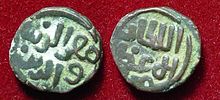- Muiz ud din Qaiqabad
-
Muiz ud din Qaiqabad (reigned 1286–1290) was the tenth sultan the Mamluk dynasty (Slave dynasty). He was the son of Bughra Khan as well as grandson of Ghiyas ud din Balban (1266–1286).
During Balban's reign, it was difficult for Balban to find an heir to the throne. His first choice, his son Muhammad (Khan Shahid), died before he could succeed Balban, his tomb stands close to Balban's tomb. Bughra Khan, Balban's second son and second choice for heir, refused the throne as he was already the governor of Bengal. Eventually, Balban chose his grandson, Kay Khusroe, to be his successor. However, when Balban died, the chiefs chose for Muiz ud din Qaiqabad to become ruler instead. Throughout his reign, Muiz ud din Qaiqabad (being still young at the time) ignored all state affairs. After four years, he suffered from a paralytic stroke and was later on murdered in 1290 by a Khilji chief. His three year old son, Kayumars (1290), succeeded him. His son though was eventually overthrown, ending the Slave dynasty and igniting the Khilji Revolution.
See also
- Mamluk dynasty of Delhi
- Delhi Sultanate
- Islamic history
- List of Indian monarchs
External links
Preceded by
Ghiyas ud din BalbanMamluk Dynasty
1206–1290Succeeded by
Kayumars of DelhiPreceded by
Ghiyas ud din BalbanSultan of Delhi
1286–1290Succeeded by
Kayumars of Delhi{{Persondata | NAME = Muiz Ud Din Qaiqabad | ALTERNATIVE NAMES = | SHORT DESCRIPTION = Sultan the [[Mamluk dynasty of Delhi | DATE OF BIRTH = | PLACE OF BIRTH = | DATE OF DEATH = 1290 | PLACE OF DEATH = }}
Categories:- 1290 deaths
- Sultans of the Mamluk Sultanate (Delhi)
- Indian royalty stubs
Wikimedia Foundation. 2010.

